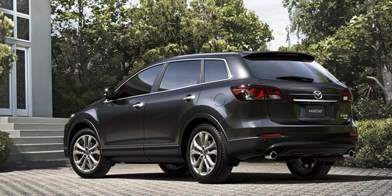Mazda is famously prickly on the subject of Battery Electric Vehicles (BEVs). While many carmakers are rushing to transition to pure-electric power, Mazda maintains that on a “well-to-wheel” basis (which includes manufacture and running), improving Internal Combustion Engine (ICE) technology can be more environmentally effective than spending up large on battery power.
If that makes Mazda’s first-ever BEV, the MX-30 Takami, seem like a grudging response to market pressure, it doesn’t come across that way. It’s arguably the most dynamically accomplished mainstream BEV you can buy, setting a benchmark for sophisticated steering, handling and ride.
But if you thought MX-30 was a standalone BEV model, you don’t know Mazda. The “MX” brand signifies a niche or specialist model (as in MX-5), and what the MX-30 specialises in is electrification. And maybe weird doors.
Mazda says it’s devised a “Multi Solution Approach” across its entire range that uses all available technology to get to a goal of carbon neutrality by 2050.
With all of that in the Mazda melting pot, it’s time to introduce the MX-30 M-Hybrid. An MX-30 with a petrol engine. That you don’t plug in.
To view all Mazda SUVs listed on DRIVEN, click here
The first curious thing is that you cannot visually tell the M-Hybrid and BEV apart, even though the former is technically a Limited specification and the latter Takami: same exterior high style, same gorgeous interior design and equipment with sustainable this, vegan that and a cork centre console. The BEV gets a heated steering wheel. That’s about it.
Of DRIVEN’s two test cars pictured here, the BEV Takami is the Ceramic Grey model, while the M-Hybrid Limited is Soul Red Crystal ($300 extra). Both also came in a very smart three-tone colour scheme (another $700).
Speaking of money, the second curious thing is that there’s $28,200 between them: the M-Hybrid is $46,790, the BEV $74,990. Even accounting for the BEV’s $8625 Clean Car Discount and the AC home charging station Mazda New Zealand supplies with the electric MX-30, there’s still in excess of $15k “real world” difference.
The Takami is relatively expensive, given its 35.5kWh capacity only gives 200km range. Mazda argues rather emphatically that city SUVs don’t need big batteries; also that big batteries make it much harder for BEV-tech to overtake ICE for eco-credibility. On that well-to-wheel logic, the BEV break-even comes around one-third of the way through a vehicle’s life with a smaller battery, but more like three-quarters for a long-range BEV.
The MX-30 M-Hybrid is so much cheaper because its 2.0-litre SkyActiv-G petrol engine is similar to that used in the entry-level CX-30 SUV; meaning it’s not the very techy SkyActiv-X mild hybrid used in the top CX-30 and Mazda3 Takami models.
The MX-30’s SkyActiv-G is combined with a 24-volt power system and small lithium-ion battery to recover, store and reuse energy normally lost during braking and deceleration. It’s not a “full” hybrid: it can’t drive on battery power alone.
How much fuel that electrification saves is hard to say because there isn’t a conventional ICE MX-30. But the M-Hybrid Limited is 55kg heavier than the CX-30 GSX and the fuel economy is virtually the same. So it’s not groundbreaking, but it is baby steps on a path towards total electrification of the Mazda fleet by 2030.
The MX-30 M-Hybrid Limited is also almost exactly the same price as the CX-30 GSX. So as a less conventional, better equipped, infinitely more avant garde alternative, the MX really stacks up.
The M-Hybrid is still a great drive by hatch/compact SUV standards. It can’t match the supple ride of the BEV Takami around town, but on the open road the steering and chassis are even better – largely because it has 200kg less weight to shift around.
The least impressive aspect is the powertrain. The 2.0-litre powerplant is slightly guttural and it’s by no means grunty. The six-speed automatic is smooth and you get three drive modes, but it could probably do with another gear or two. Don’t tell Mazda: it also has very firm views on the “rightsizing” of engines and transmissions.
But if you’re keyed into the striking design and don’t need a full five-door configuration, the MX-30 M-Hybrid is a hugely appealing compact-SUV: good to drive, great to be in.
If you still yearn for the MX-30 BEV but can’t get past the $15k post-rebate premium over the M-Hybrid, consider this: if you charge the Takami at home, you can recover that premium in about 45,000km of driving. Over three or four years that’s actually quite do-able.
MAZDA MX-30
ENGINE: 2.0-litre petrol with mild hybrid system (M-Hybrid Limited) or 35.5kWh lithium-ion battery with single electric motor (BEV Takami)
POWER: 114kW/200Nm (Limited) or 107kW/271Nm (Takami)
GEARBOX: 6-speed automatic (Limited) or single-speed (Takami), FWD
ECONOMY/POWER CONSUMPTION: 6.4l/100km (Limited) or 17.5kWh/100km, WLTP range 200km (Takami)
PRICES: $46,790 (Limited) or $74,990 (Takami)





